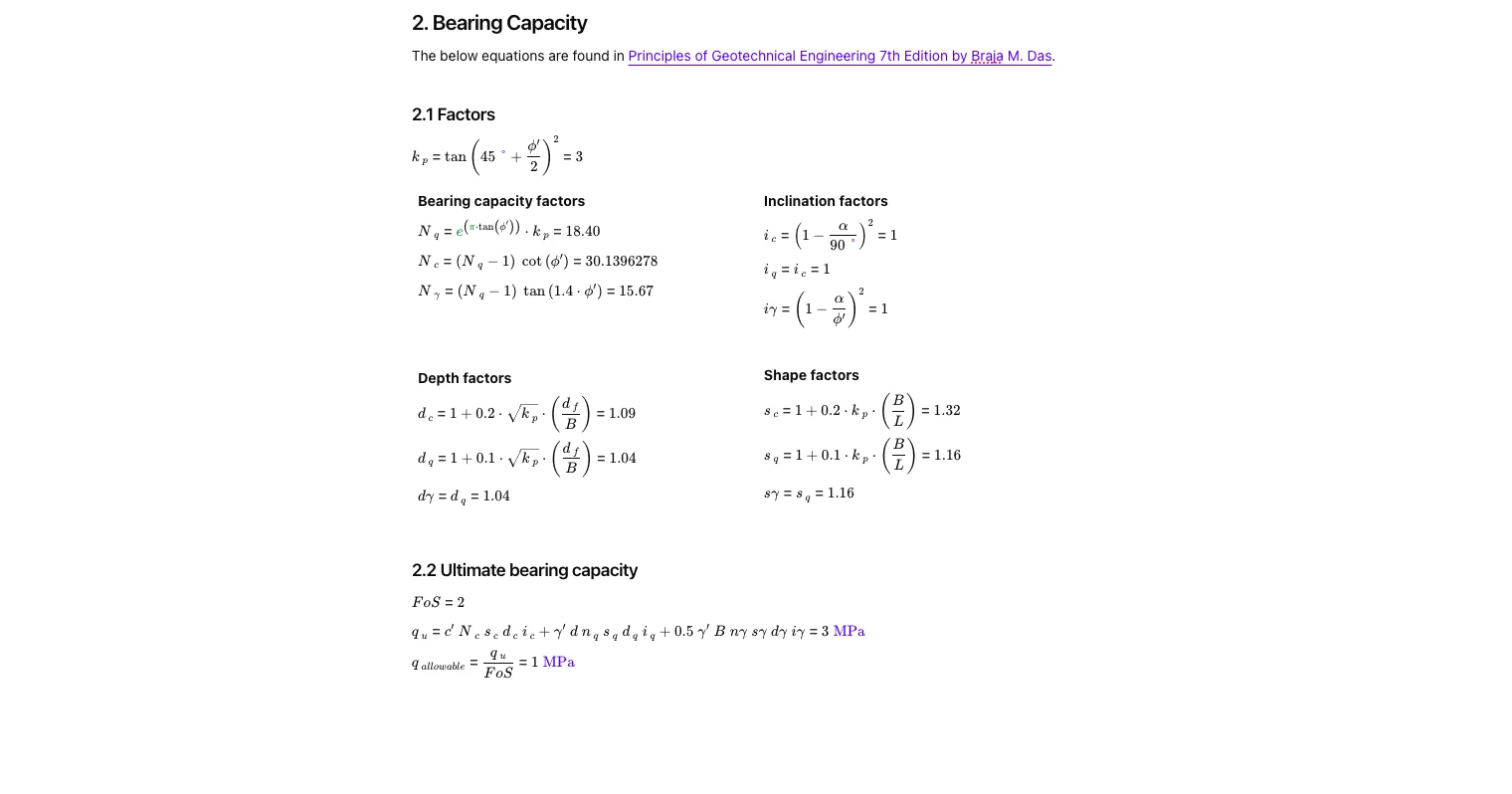Fast, engineering-grade Meyerhof bearing capacity calculator. Inputs, factors, and checks for shallow foundations with clear outputs and downloadable report.

This template is not available yet. You can sign up and create it yourself!
Or let us know if you'd like to be notified when it’s ready:
About this Bearing Capacity Calculator
This calculator computes the ultimate and allowable bearing capacity of a shallow foundation using Meyerhof’s method. It’s been verified against standard textbook equations and presents all intermediate factors for traceability.
- Geotechnical engineer — size footings quickly from basic soil parameters and depth, with shape, depth, and inclination factors shown.
- Structural engineer — confirm allowable soil pressure for footing design loads and iterate on B, L, and embedment without leaving your calc.
- Civil designer — run rapid “what-if” checks on pad footings during concept and value-engineering phases.
The tool exposes every coefficient used (Nc, Nq, Nγ; sc, sq, sγ; dc, dq, dγ; ic, iq, iγ) and applies a user-defined factor of safety for allowable pressure. It’s an engineering-grade calculator you can audit, adapt, and save to a project page in CalcTree.
More info on Meyerhof Bearing Capacity
Inputs
Based on the template:
- Footing geometry: embedment depth Df, width B, length L, and load inclination angle α (relative to vertical).
- Soil properties (drained): effective friction angle φ′, cohesion c′, and effective unit weight γ′.
A simple footing sketch clarifies dimensions and load application.
Bearing-capacity factors
The calculator derives:
- kp from tan(45° + φ′/2) squared.
- Nq via an exponential function of φ′ and kp.
- Nc from (Nq − 1)·cot φ′.
- Nγ from (Nq − 1)·tan(1.4·φ′).
These follow the presentation from Principles of Geotechnical Engineering (Braja M. Das).
Modification factors
It applies Meyerhof’s modifiers exactly as shown in the template:
- Depth factors: dc, dq, dγ as functions of kp and Df/B.
- Shape factors: sc, sq, sγ as functions of kp and B/L.
- Inclination factors: ic, iq, iγ as functions of α and, where applicable, φ′.
All factors are printed so you can check sensitivity and design margins.
Outputs and design checks
- Ultimate bearing capacity (qu):
qu = c′·Nc·sc·dc·ic + γ′·Df·Nq·sq·dq·iq + 0.5·γ′·B·Nγ·sγ·dγ·iγ - Allowable bearing pressure (qallowable):
qallowable = qu / FoS, where FoS is user-defined.
Results are given with units and rounded sensibly for design.
If you’re building a library of geotechnical calcs, add this page to your workspace and link it with other foundation tools from the CalcTree Templates.
Common Calculation Errors to Avoid
- Using undrained parameters with the drained Meyerhof formulation — keep φ′, c′, and γ′ consistent with the drained assumption or use the appropriate method for undrained cases.
- Forgetting shape and depth modifiers — leaving out sc, sq, sγ or dc, dq, dγ can overstate capacity, especially for narrow or deeply embedded footings.
- Ignoring load inclination — set α and apply ic, iq, iγ; a non-vertical load reduces capacity.
- Mixing total and effective unit weights — use γ′ for submerged conditions and γ for dry; the wrong choice skews Nq and surcharge terms.
- Applying the wrong factor of safety — document FoS clearly; allowable pressure is directly proportional to this choice.
- Using B and L inconsistently — ensure width B and length L match the footing orientation used in the factors.
Engineering templates
Common calculators
Design guides
FAQs
When should I use Meyerhof’s method instead of Terzaghi or Vesic?
Meyerhof includes practical shape, depth, and load-inclination modifiers in a compact form. It’s a solid default for shallow foundations under inclined loads or non-square shapes. If you need more detailed strain-failure treatment or local code-specific charts, compare with Vesic or local guidance.
What units does the calculator use?
Inputs and outputs are fully unit-aware. Enter any consistent SI units for length, stress, and unit weight; the page handles conversions and displays results with units.
How does the tool handle submerged conditions?
Use effective unit weight γ′ for the bearing-capacity terms and effective stress parameters (φ′, c′). If soil is below the water table, set γ′ accordingly; the surcharge term uses γ′·Df per the template.
Can I use this for strip footings and rectangular pads?
Yes. Provide B and L; shape factors adjust capacity for rectangular vs. square geometry. For long wall footings (B ≪ L), results approach strip footing behavior via the shape factors.
How is allowable bearing pressure calculated?
The calculator reports qu and then divides by your chosen factor of safety to give qallowable. Set FoS per your practice or project requirements.
Can I save and share this setup with my team?
Yes. Duplicate the template, lock inputs, and share with others inside your team workspace.
Learn about the benefits of using CalcTree on engineering projects!





